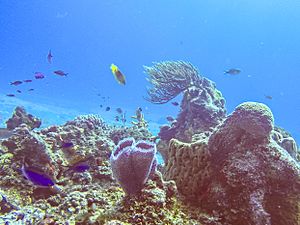Mesoamerican Barrier Reef System facts for kids
The Mesoamerican Barrier Reef System (MBRS) is a huge underwater world. People also call it the Great Mayan Reef. It is one of the biggest coral reef systems on Earth. This amazing marine area stretches for over 1,126 kilometers (700 miles). It runs along the coasts of four countries: Mexico, Belize, Guatemala, and Honduras.
The reef starts near Isla Contoy in Mexico. This is at the northern tip of the Yucatán Peninsula. It then goes south past places like Cozumel and Banco Chinchorro. The reef continues along the eastern coast of Belize. Here you can find many small islands called cayes and atolls. Finally, it reaches the north-east part of Honduras.
Many special places are part of this reef system. These include the Belize Barrier Reef and Arrecifes de Cozumel National Park. Other protected areas are the Hol Chan Marine Reserve in Belize and Sian Ka'an biosphere reserve. The Cayos Cochinos Marine Park is also part of it. About 30% of the entire reef system is found along Belize's coast.
Contents
Amazing Ocean Life
The Mesoamerican Barrier Reef System is full of life. It is home to more than 65 types of stony coral. You can also find 350 kinds of mollusks here. Over 500 different species of fish live in these waters.
Many animals living here are special. Some are even endangered or protected. These include several types of sea turtles. You might see the green sea turtle, loggerhead sea turtle, leatherback turtle, and hawksbill turtle. Other important creatures are the queen conch and the West Indian manatee. The unique splendid toadfish also lives here. You can also find the American crocodile and the Morelet's crocodile. Important fish like the Nassau grouper swim around. Even corals like elkhorn coral and black coral are protected.
Manatees and Whale Sharks
The reef system is a very important home for manatees. It has one of the world's largest groups of these gentle giants. Experts believe there are about 1,000 to 1,500 manatees living here.
In the northern parts of the reef, near Isla Contoy, you can find the biggest fish on Earth. This is the amazing whale shark. These huge sharks usually swim alone. But in this area, they gather in groups. They come together to eat and to find mates.
The Lionfish Challenge
The reef system is facing a big problem. An invasive fish called the red lionfish has arrived. These fish are not from this area. They originally come from the Indo-Pacific region.
Lionfish cause a lot of harm to the reef. They eat almost every type of fish that helps the reef stay healthy. For example, they eat cleaner shrimp. These shrimp and other animals clean the corals. They keep the corals alive and free from disease. Lionfish can eat up to 90% of these helpful species in just a few months. This can cause the coral reef to die quickly. Important seafood like lobster are also being affected. This is because lionfish eat so much.
Protecting the Reef
The Mesoamerican Barrier Reef System is very important. It is also in danger. Experts say it is "critically endangered." This means it needs a lot of help to survive. Many groups are working to protect this amazing underwater world.
See also
 In Spanish: Sistema Arrecifal Mesoamericano para niños
In Spanish: Sistema Arrecifal Mesoamericano para niños
- List of reefs
- Assisted evolution
- Coral Reef Alliance



